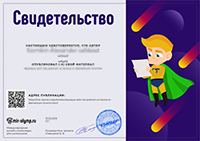Lesson plan
| LESSON: Module 5 Lesson 10
| School: 28 | ||||||
| Date:29.01.2019 | Teacher name: Ryskhanova K.K. | ||||||
| CLASS: 5 | Number present: | absent: | |||||
| The title | Describing a past event | ||||||
| Learning objectives(s) that this lesson is contributing to |
5.S6communicate meaning clearly at sentence level during, pair, group and whole class exchanges | ||||||
| Lesson objectives | All learners will be able to: Recognize particular information and details while listening | ||||||
| Most learners will be able to: communicate meaning clearly at discourse level while discussing | |||||||
| Some learners will be able to: Demonstrate speaking and listening skills to solve problems creatively and cooperatively in pairs/groups | |||||||
| | |||||||
| Assessment criteria | Identify the main information of a talk using supporting information Interact with each other delivering content correctly and clearly to others | ||||||
| Value links | National unity, peace and harmony | ||||||
| Previous learning | some past simple regular forms and some common irregular ones | ||||||
| Plan | |||||||
| Planned timings | Planned activities | Excel | Teacher | ||||
| Beginning the lesson | Teacher greets students. Lead –in. Look around the classroom. What can you see? What do they mean? They are time expressions of Past Simple. What do you think the theme of this lesson will be? What will you do at the lesson? The theme of our lesson is Describing a past event. We will listen and talk about your past events. |
|
| ||||
|
| Main activities | Pre-listening task. Look at these words. Repeat after me. Listening. Listen to the dialogues. People are talking about their past events in their lives. Listen and number the pictures. Post-listening task. Listen again. When did the events happen? Circle the correct answer above. Descriptor: A learner 1. Listens and number the pictures 2. Circle the correct time expressions. FA(Self-assessment) Speaking. Work in pairs. Open your books on page 69 ex8. Use these verbs to find out what your partner did last weekend. Give short answer. Inside-Outside Circle strategy.(The inside-outside circle is a strategy that can provide you with information about student learning. Divide your students into two groups. One group is the inside circle and the other group forms the outside circle. Students pair up with other students in the opposing circle and face one another. The inside circle begins by responding to a question or statement provided by the teacher. After a set amount of time--perhaps a minute or two, students reverse roles and the outside partners respond. While students are responding, circulate around the circles and listen to comments and explanations being shared.) Give full answer. FA(peer-assessment)
And now it’s time to talk. Stand in two rows face to face. I’ll give some cards with irregular verbs .Without stopping you should give the second form of these verbs and their translations. Speak loudly. You have only one minute. Group work. You should divide into three groups. Look at your desks there are some stickers with time expressions. Think about a happy event in your life. It can be something that happened a long time ago or very recently. Make notes about the events in the chart. Tell the class about your happy event. FA (group assessment)
|
| Worksheet1
Worksheet2
Worksheet3
|
| ||||||||
|
| Ending the lesson | Giving the hometask Self-reflection.
If children liked something at the lesson they put it into the column “plus”, if they didn’t like or were bored during some part of the lesson, they can use the column “minus”, the section “interesting” is for those activities which were interesting during the lesson. |
|
| | ||||||||
| | Additional information | | |||||||||||
| | Differentiation – how do you plan to give more support? How do you plan to challenge the more able learners? | Assessment – how are you planning to check learners’ learning? | Cross-curricular links | ||||||||||
| | monitor less able groups in controlled tasks and highlight any errors in forms for learners to self-correct | monitor pair sentence completion tasks and encourage learners to give feedback to each other on answers | cross-curricular links: Literature [world literature] | ||||||||||
| | challenge more able learners to produce different time phrases when talking about the past | monitor pronunciation of target verbs and remodel and drill to whole class | | | |||||||||


 1244
1244 55
55 Describing a past event
Describing a past event 